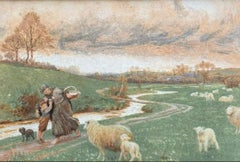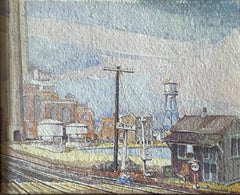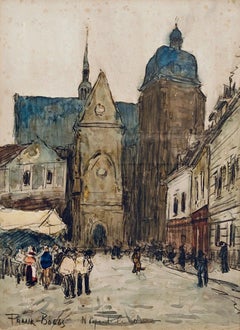Frederick Walker Landscape Paintings
to
1
Overall Width
to
Overall Height
to
1
1
1
1
1
1
1
1
1
1
678
605
307
232
1
1
Artist: Frederick Walker
The Right of Way
By Frederick Walker
Located in London, GB
Frederick Walker
The Right of Way
1840-1875
Watercolour and bodycolour on paper
Image size: 12 x 8 inches (30.5 x 20.25 cm)
Handmade Pre-Raphaelite style frame
In this pastoral scen...
Category
19th Century Frederick Walker Landscape Paintings
Materials
Paper, Watercolor
Related Items
"Train Station, " Max Kuehne, Industrial City Scene, American Impressionism
By Max Kuehne
Located in New York, NY
Max Kuehne (1880 - 1968)
Train Station, circa 1910
Watercolor on paper
8 1/4 x 10 1/4 inches
Signed lower right
Provenance:
Private Collection, Illinois
Max Kuehne was born in Halle, Germany on November 7, 1880. During his adolescence the family immigrated to America and settled in Flushing, New York. As a young man, Max was active in rowing events, bicycle racing, swimming and sailing. After experimenting with various occupations, Kuehne decided to study art, which led him to William Merritt Chase's famous school in New York; he was trained by Chase himself, then by Kenneth Hayes Miller. Chase was at the peak of his career, and his portraits were especially in demand. Kuehne would have profited from Chase's invaluable lessons in technique, as well as his inspirational personality. Miller, only four years older than Kuehne, was another of the many artists to benefit from Chase's teachings. Even though Miller still would have been under the spell of Chase upon Kuehne's arrival, he was already experimenting with an aestheticism that went beyond Chase's realism and virtuosity of the brush. Later Miller developed a style dependent upon volumetric figures that recall Italian Renaissance prototypes.
Kuehne moved from Miller to Robert Henri in 1909. Rockwell Kent, who also studied under Chase, Miller, and Henri, expressed what he felt were their respective contributions: "As Chase had taught us to use our eyes, and Henri to enlist our hearts, Miller called on us to use our heads." (Rockwell Kent, It's Me O Lord: The Autobiography of Rockwell Kent. New York: Dodd, Mead and Co., 1955, p. 83). Henri prompted Kuehne to search out the unvarnished realities of urban living; a notable portion of Henri's stylistic formula was incorporated into his work.
Having received such a thorough foundation in art, Kuehne spent a year in Europe's major art museums to study techniques of the old masters. His son Richard named Ernest Lawson as one of Max Kuehne's European traveling companions. In 1911 Kuehne moved to New York where he maintained a studio and painted everyday scenes around him, using the rather Manet-like, dark palette of Henri.
A trip to Gloucester during the following summer engendered a brighter palette. In the words of Gallatin (1924, p. 60), during that summer Kuehne "executed some of his most successful pictures, paintings full of sunlight . . . revealing the fact that he was becoming a colorist of considerable distinction." Kuehne was away in England the year of the Armory Show (1913), where he worked on powerful, painterly seascapes on the rocky shores of Cornwall. Possibly inspired by Henri - who had discovered Madrid in 1900 then took classes there in 1906, 1908 and 1912 - Kuehne visited Spain in 1914; in all, he would spend three years there, maintaining a studio in Granada. He developed his own impressionism and a greater simplicity while in Spain, under the influence of the brilliant Mediterranean light. George Bellows convinced Kuehne to spend the summer of 1919 in Rockport, Maine (near Camden). The influence of Bellows was more than casual; he would have intensified Kuehne's commitment to paint life "in the raw" around him.
After another brief trip to Spain in 1920, Kuehne went to the other Rockport (Cape Ann, Massachusetts) where he was accepted as a member of the vigorous art colony, spearheaded by Aldro T. Hibbard. Rockport's picturesque ambiance fulfilled the needs of an artist-sailor: as a writer in the Gloucester Daily Times explained, "Max Kuehne came to Rockport to paint, but he stayed to sail." The 1920s was a boom decade for Cape Ann, as it was for the rest of the nation. Kuehne's studio in Rockport was formerly occupied by Jonas Lie.
Kuehne spent the summer of 1923 in Paris, where in July, André Breton started a brawl as the curtain went up on a play by his rival Tristan Tzara; the event signified the demise of the Dada movement. Kuehne could not relate to this avant-garde art but was apparently influenced by more traditional painters — the Fauves, Nabis, and painters such as Bonnard. Gallatin perceived a looser handling and more brilliant color in the pictures Kuehne brought back to the States in the fall. In 1926, Kuehne won the First Honorable Mention at the Carnegie Institute, and he re-exhibited there, for example, in 1937 (Before the Wind). Besides painting, Kuehne did sculpture, decorative screens, and furniture work with carved and gilded molding. In addition, he designed and carved his own frames, and John Taylor Adams encouraged Kuehne to execute etchings. Through his talents in all these media he was able to survive the Depression, and during the 1940s and 1950s these activities almost eclipsed his easel painting. In later years, Kuehne's landscapes and still-lifes show the influence of Cézanne and Bonnard, and his style changed radically.
Max Kuehne died in 1968. He exhibited his work at the National Academy of Design, the Art Institute of Chicago, the Carnegie Institute in Pittsburgh, the Memorial Art Gallery of the University of Rochester, and in various New York City galleries. Kuehne's works are in the following public collections: the Detroit Institute of Arts (Marine Headland), the Whitney Museum (Diamond Hill...
Category
1910s American Impressionist Frederick Walker Landscape Paintings
Materials
Paper, Watercolor
$2,800 Sale Price
20% Off
H 13.5 in W 15.5 in
"Nogent-le-Roi" Frank Myers Boggs, Atmospheric French Urban Landscape
By Frank Myers Boggs
Located in New York, NY
Frank Myers Boggs
Nogent-le-Roi
Signed and titled lower left
Graphite and watercolor on paper
13 1/2 x 10 1/4 inches
The Impressionist Frank Myers Boggs spent his formative and mat...
Category
Early 1900s Impressionist Frederick Walker Landscape Paintings
Materials
Paper, Watercolor
$960 Sale Price
20% Off
H 19.25 in W 16 in
Forest landscape with river Paper, watercolor. 41x58 cm
By Edgars Vinters
Located in Riga, LV
Forest landscape with river
Paper, watercolor. 41x58 cm
Edgars Vinters (1919-2014)
Edgars Vinters is working in oil, watercolor and monotype techniques. He paints landscapes in dif...
Category
1980s Impressionist Frederick Walker Landscape Paintings
Materials
Paper, Watercolor
$717 Sale Price
20% Off
H 16.15 in W 22.84 in D 0.04 in
"Market Scene, North Africa" Martha Walter, Female Impressionist Scene of Market
By Martha Walter
Located in New York, NY
Martha Walter
Market Scene, North Africa
Signed lower right
Watercolor on paper
9 x 9 inches
Martha Walter was best known as a painter of colorful beach scenes and landscapes. Infl...
Category
Early 20th Century Impressionist Frederick Walker Landscape Paintings
Materials
Paper, Watercolor
"New York City Skyline View from the East River, " Lionel Reiss, Jewish Artist
By Lionel Reiss
Located in New York, NY
Lionel S. Reiss (1894 - 1988)
New York City Skyline View from the East River
Watercolor on paper
13 x 19 inches
Signed lower left
In describing his own style, Lionel Reiss wrote, “By nature, inclination, and training, I have long since recognized the fact that...I belong to the category of those who can only gladly affirm the reality of the world I live in.” Reiss’s subject matter was wide-ranging, including gritty New York scenes, landscapes of bucolic Bucks County, Pennsylvania, and seascapes around Gloucester, Massachusetts. However, it was as a painter of Jewish life—both in Israel and in Europe before World War II—that Reiss excelled. I.B. Singer, the Nobel Prize winner for Literature, noted that Reiss was “essentially an artist of the nineteenth century, and because of this he had the power and the courage to tell visually the story of a people.”
Although Reiss was born in Jaroslaw, Poland, his family immigrated to the United States in 1898 when he was four years old. Reiss's family settled on New York City’s Lower East Side and he lived in the city for most of his life. Reiss attended the Art Students League and then worked as a commercial artist for newspapers and publishers. As art director for Metro-Goldwyn-Mayer, he supposedly created the studio’s famous lion logo.
After World War I, Reiss became fascinated with Jewish life in the ‘Old World.’ In 1921 he left his advertising work and spent the next ten years traveling in Europe, the Middle East, and North Africa. Like noted Jewish photographers Alter Kacyzne and Roman Vishniac, Reiss depicted Jewish life in Poland prior to World War II. He later wrote, “My trip encompassed three main objectives: to make ethnic studies of Jewish types wherever I traveled; to paint and draw Jewish life, as I saw it and felt it, in all aspects; and to round out my work in Israel.”
In Europe, Reiss recorded quotidian scenes in a variety of media and different settings such as Paris, Amsterdam, the Venice ghetto, the Jewish cemetery in Prague, and an array of shops, synagogues, streets, and marketplaces in the Jewish quarters of Warsaw, Lodz, Krakow, Lublin, Vilna, Ternopil, and Kovno. He paid great attention to details of dress, hair, and facial features, and his work became noted for its descriptive quality.
A selection of Reiss’s portraits appeared in 1938 in his book My Models Were Jews. In this book, published on the eve of the Holocaust, Reiss argued that there was “no such thing as a ‘Jewish race’.” Instead, he claimed that the Jewish people were a cultural group with a great deal of diversity within and between Jewish communities around the world. Franz Boas...
Category
1940s American Modern Frederick Walker Landscape Paintings
Materials
Paper, Watercolor
$2,800 Sale Price
20% Off
H 28 in W 32 in
Sunset 1970, paper/watercolor., 20x24 cm
Located in Riga, LV
Sunset
1970, paper/watercolor., 20x24 cm
Herberts Mangolds (1901-1978)
Graphic, army officer.
In 1920 he graduated from the Artillery Cadet School ...
Category
1970s Realist Frederick Walker Landscape Paintings
Materials
Paper, Watercolor
The path along the river in winter. Paper, watercolor, 40x55, 5 cm
Located in Riga, LV
The path along the river in winter. Paper, watercolor, 40x55,5 cm
Landscape, winter morning by the river
Arnolds Pankoks (born 1914.21.IX - 2008.)
Graduated Art Academy of Latvia (1...
Category
1990s Impressionist Frederick Walker Landscape Paintings
Materials
Paper, Watercolor
$699 Sale Price
25% Off
H 15.75 in W 21.86 in D 0.04 in
Landscape 1961, paper/watercolor, 20x23.5 cm
Located in Riga, LV
Landscape
1961, paper/watercolor, 20x23.5 cm
Herberts Mangolds (1901-1978)
Graphic, army officer.
In 1920 he graduated from the Artillery Cadet School of Latvian and many military ...
Category
1960s Realist Frederick Walker Landscape Paintings
Materials
Paper, Watercolor
$215
H 7.88 in W 9.26 in D 0.04 in
Landscape in the winter 1969, paper/watercolor, 20x22.5 cm
Located in Riga, LV
Landscape in the winter
1969, paper/watercolor, 20x22.5 cm
Herberts Mangolds (1901-1978)
Graphic, army officer.
In 1920 he graduated from the Artillery Cadet School of Latvian and ...
Category
1960s Realist Frederick Walker Landscape Paintings
Materials
Paper, Watercolor
$215
H 7.88 in W 8.86 in D 0.04 in
Winter city. 1980. Paper, watercolor, 68x40 cm
By Edwin Andersons
Located in Riga, LV
Winter city. 1980. Paper, watercolor, 68x40 cm
Street with buildings in snow
Edwin Andersons (1929-1996)
1956 – graduating Art Academy of Latvia, dep...
Category
1980s Impressionist Frederick Walker Landscape Paintings
Materials
Paper, Watercolor
$2,983
H 26.78 in W 15.75 in D 0.04 in
Taped Sky
By Catherine Koenig
Located in Buffalo, NY
An original watercolor painting by American artist Catherine Koenig.
Category
1980s Realist Frederick Walker Landscape Paintings
Materials
Archival Paper, Watercolor
Hill 1969, paper/watercolor, 17.5x25 cm
Located in Riga, LV
Hill
1969, paper/watercolor, 17.5x25 cm
Herberts Mangolds (1901-1978)
Graphic, army officer.
In 1920 he graduated from the Artillery Cadet School o...
Category
1960s Realist Frederick Walker Landscape Paintings
Materials
Paper, Watercolor
Frederick Walker landscape paintings for sale on 1stDibs.
Find a wide variety of authentic Frederick Walker landscape paintings available for sale on 1stDibs. You can also browse by medium to find art by Frederick Walker in paint, paper, watercolor and more. Not every interior allows for large Frederick Walker landscape paintings, so small editions measuring 8 inches across are available. Customers who are interested in this artist might also find the work of Henry H. Parker, Walter Williams, and William Mellor.


